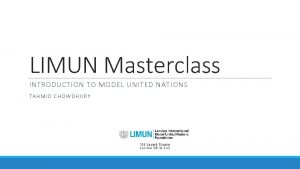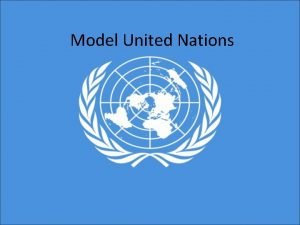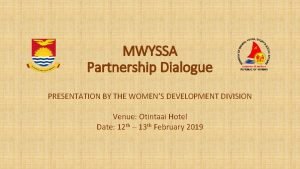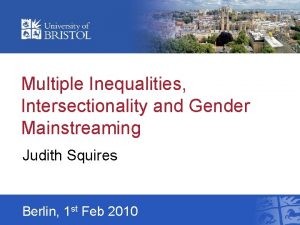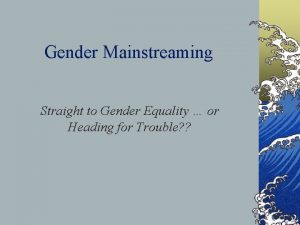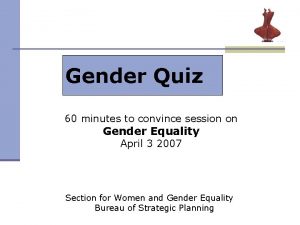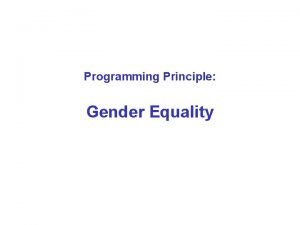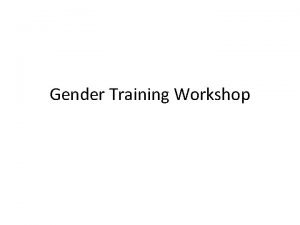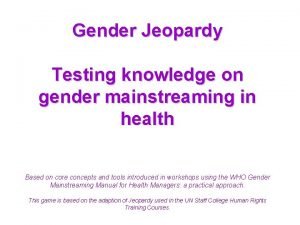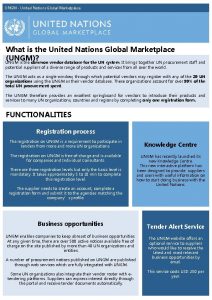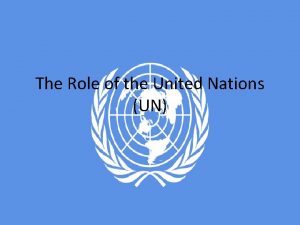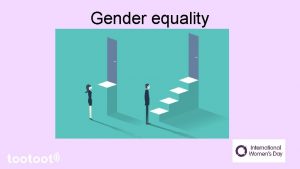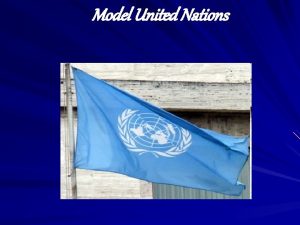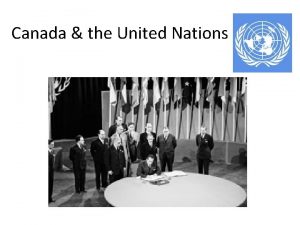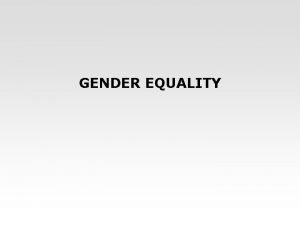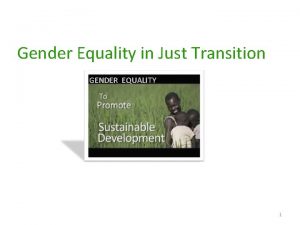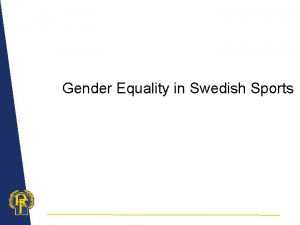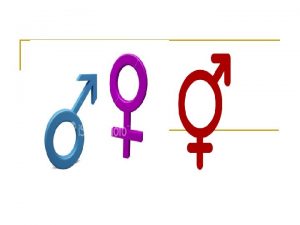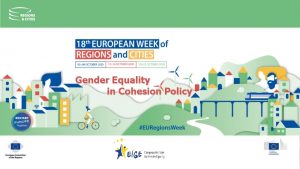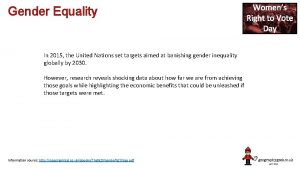Jr Model United Nations Preparatory Conference Gender Equality





















- Slides: 21

Jr. Model United Nations Preparatory Conference Gender Equality and Economic Development Presented by: Mr. Alex Otieno, Arcadia University Wednesday, March 12 & Thursday, March 13, 2014 Temple University, Fox School of Business · Philadelphia, Pennsylvania

Gender Equality and Economic Development: Pathways to Progress Alex Otieno Arcadia University

The Concern- An Unfulfilled Obligation

Are Gender Equality and Economic Development Achievable? • What is gender equality and why does it matter to economic development? • How do we make gender equality both possible and desirable? • How do we sustain and expand on progress made in gender equality and development?

What are Millennium Development Goals? • 1 Eradicate extreme poverty and hunger • • 2 Achieve universal primary education 3 Promote gender equality and empower women 4 Reduce child mortality 5 Improve maternal health 6 Combat HIV / AIDS, malaria and other diseases 7 Ensure environmental sustainability 8 Develop a global partnership for development

What we know • UN Member States can make tangible impacts on all development goals • Gender equality requires ongoing commitment

Gender Inequality and Women’s Status • Are women and girls discriminated against in health, education, labor market and politics? • Gender Inequality Index (GII) measures how gender negatively impacts freedoms – Maternal mortality ratio – Adolescent fertility rate (birth rate/1000 15 -19 yr olds) – Seats in national Parliament (% of females) – Population over 25 with at least secondary education – Labor force participation rate for 15 year olds

Growth as Path to Equality: Shifting into Gear • Create policies aimed at facilitating the link between economic growth and equality • Increase women’s economic opportunities – Through markets, formal and informal institutions • Increase women’s agency, endowments, and economic opportunities

Intersection of International and National Issues • Support equal opportunity laws and practices that reduce unequal participation in politics, education, and economics • Invest in infrastructure/increase women’s role in the labor market as a way of building capability and economic independence • Review national, regional and global progress in achieving equal opportunity

Protect and Promote Human Rights • Freedom and opportunity to maximize individual potential regardless of sex • Duty bearers to protect, promote and fulfill health and development rights • Responsibility to facilitate partnership for progressive realization of goals

Case: Gender Parity in Political Representation • You agreed on achieving 30% women in parliaments or national assemblies • Women still comprise only 21. 4 percent of elected representatives worldwide • Latin America has more than 24% of women MPs — one of the highest shares in the world — the region still has a long road to travel towards gender parity

Impact of Quotas Mandated by Law COUNTRY Proportion of women representatives before law ARGENTINA 8. 7 Proportion of women representative s after law 37. 4 COSTA RICA 15. 8 38. 6 NICARAGUA 18. 4 40. 2

Priorities from Four-Year Review • Strategic thinking in reducing gender gaps and facilitating human development • A gender-based approach to MDGs has potentially large payoffs • Address limits of income-based approach and reorient public policies towards equity and empowerment

How Can Delegates Help? • Collaboration on poverty reduction in low income countries (global south) • Focus on partnerships among high, middle and low income countries • Work towards improved governance, peace, social justice and stability

"Equality for Women is Progress for All" • Include small farmers and the informal private sector in models of economic development • Create space/engage in dialogue fostering women’s participation in politics • Facilitate access to justice and use law and the judiciary to advance empowerment and equity

Reinforce Role of Institutions • Use law and justice system to enhance role of institutions in equality and sustainable development • Open spaces for women’s political involvement • Review current strategies with a view of ensuring gender equality

Link Equality, Development and Rights • Identify social and political action necessary for making gender equality and development urgent matters • Pursue social justice and accountability – Particular attention to women • Create structures for increasing access to justice and rule of law

Equality and Effective Economics • Integrate human rights into all important development policies • Use development assistance to promote women’s human rights • Invest in programs that foster gender equity and economic development

Way Forward- Share Knowledge and Information • Provide financial support and strategic partnerships for evidence-based action • Improve political participation, access to justice and rule of law • Use international and local evidence from reviews in advocacy for change – Prevailing inequities supported by norms and practices


References • • • Boserups, E. 1970. Women's Role in Economic Development. London: George Allen and Unwin. Coontz, S. 2013. Why Gender Equality Stalled. The New York Times (February 17), SR 1, SR 6– 7. United Nations. 2010. Achieving Gender Equality, Women's Empowerment and Strengthening Development Cooperation. Available online at http: //www. un. org/en/ecosoc/docs/pdfs/1050143_(e)_(desa)dialogues_ecosoc_achieving_gender_equality_women_empowerme nt. pdf United Nations 2012. Dialogues at the Economic and Social Council. Online at http: //www. un. org/en/ecosoc/docs/pdfs/dialogues_at_ecosoc_2012. pdf Wasserman DL. 2010. Using a systems orientation and foundational theory to enhance theory-driven human service program evaluations. Eval Program Plann, 33(2): 67 -80. http: //www. economist. com/node/6800723 Discussion on the impact of women being part of the education system as well as the economic system as a way of increasing countries outputs. Relates to child birth and participation in work.
 Introduction to model united nations
Introduction to model united nations What is mun
What is mun Junior model united nations
Junior model united nations Strategic gender needs and practical gender needs
Strategic gender needs and practical gender needs Gender equality is more than a goal in itself
Gender equality is more than a goal in itself Rhetorical questions about gender equality
Rhetorical questions about gender equality Gender equality definition
Gender equality definition What is gender equality answer
What is gender equality answer Methodology of gender inequality
Methodology of gender inequality Conclusion of kothari commission
Conclusion of kothari commission Short poem on gender equality
Short poem on gender equality Example of gender equality
Example of gender equality Slogan about gender equality
Slogan about gender equality Gender inequality case study
Gender inequality case study Formal equality vs substantive equality
Formal equality vs substantive equality Substantive equality vs formal equality
Substantive equality vs formal equality United nations
United nations Undss usg
Undss usg Ungm
Ungm Six main organs of the united nations
Six main organs of the united nations What is the role of the united nations?
What is the role of the united nations? Ethics and integrity at the united nations
Ethics and integrity at the united nations
